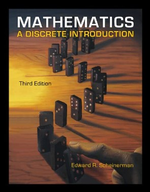More about conjectures. Where do new theorems come from They are the creations of
Chapter 4, Problem 4.12(choose chapter or problem)
More about conjectures. Where do new theorems come from? They are the creations of mathematicians that begin as conjectures: statements about mathematics whose truth we have yet to establish. In other words, conjectures are guesses (usually, educated guesses). By looking at many examples and hunting for patterns, mathematicians express their observations as statements they hope to prove. The following items are designed to lead you through the process of making conjectures. In each case, try out several examples and attempt to formulate your observations as a theorem to be proved. You do not have to prove these statements; for now we simply want you to express what you find in the language of mathematics. a. What can you say about the sum of consecutive odd numbers starting with 1? That is, evaluate 1, 1C3, 1C3C5, 1C3C5C7, and so on, and formulate a conjecture. b. What can you say about the sum of consecutive perfect cubes, starting with 1. That is, what can you say about 1 3 , 1 3 C 3 3 , 1 3 C 3 3 C 5 3 , 1 3 C 3 3 C 5 3 C 7 3 , and so on. c. Let n be a positive integer. Draw n lines (no two of which are parallel) in the plane.How many regions are formed?d. Place n points evenly around a circle. Starting at one point, draw a path to everyother point around the circle until returning to start. In some instances, every pointis visited and in some instances some are missed. Under what circumstances is everypoint visited (as in the figure with n D 9)?Suppose instead of jumping to every second point, we jump to every third point. Forwhat values of n does the path touch every point?Finally, suppose we visit every kth point (where k is between 1 and n). When doesthe path touch every point?e. A school has a long hallway of lockers numbered 1, 2, 3, and so on up to 1000.In this problem well refer to flipping a locker to mean opening a closed locker orclosing an open locker. That is, to flip a locker is to change its closed/open state. Student #1 walks down the hallway and closes all the lockers. Student #2 walks down the hallway and flips all the even numbered lockers. Sonow, the odd lockers are closed and the even lockers are open. Student #3 walks down the hall and flips all the lockers that are divisible by 3. Student #4 walks down the hall and flips all the lockers that are divisible by 4. Likewise students 5, 6, 7, and so on walk down the hall in turn, each flippinglockers divisible by their own number until finally student 1000 flips the (oneand only) locker divisible by 1000 (the last locker).Which lockers are open and which are closed? Generalize to any number of lockers.Note: We ask you to prove your conjecture later; see Exercise 24.19.
Unfortunately, we don't have that question answered yet. But you can get it answered in just 5 hours by Logging in or Becoming a subscriber.
Becoming a subscriber
Or look for another answer
